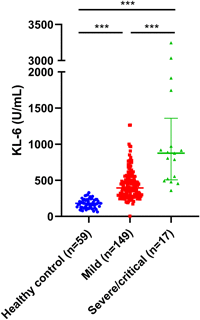Prognostic roles of KL-6 in disease severity and lung injury in COVID-19 patients: A longitudinal retrospective analysis
- PMID: 33433006
- PMCID: PMC8013517
- DOI: 10.1002/jmv.26793
Prognostic roles of KL-6 in disease severity and lung injury in COVID-19 patients: A longitudinal retrospective analysis
Abstract
To investigate the dynamic changes of Krebs von den Lungen-6 (KL-6) among patients with coronavirus disease 2019 (COVID-19) and the role of KL-6 as a noninvasive biomarker for predicting long-term lung injury, the clinical information and laboratory tests of 166 COVID-19 patients were collected, and a correlation analysis between KL-6 and other parameters was conducted. There were 17 (10.2%, 17/166) severe/critical and 149 (89.8%, 149/166) mild COVID-19 patients in our cohort. Serum KL-6 was significantly higher in severe/critical COVID-19 patients than in mild patients (median 898.0 vs. 451.2 U/ml, p < .001). KL-6 was next confirmed to be a sensitive and specific biomarker for distinguishing mild and severe/critical patients and correlate to computed tomography lung lesions areas. Serum KL-6 concentration during the follow-up period (>100 days postonset) was well correlated to those concentrations within 10 days postonset (Pearson r = .867, p < .001), indicating the prognostic value of KL-6 levels in predicting lung injury after discharge. Finally, elevated KL-6 was found to be significantly correlated to coagulation disorders, and T cells subsets dysfunctions. In summary, serum KL-6 is a biomarker for assessing COVID-19 severity and predicting the prognosis of lung injury of discharged patients.
Keywords: COVID-19; KL-6; lung injury; prognosis.
© 2021 Wiley Periodicals LLC.
Conflict of interest statement
The authors declare that there are no conflict of interests.
Figures




Similar articles
-
Serum Krebs von den Lungen-6 for Predicting the Severity of COVID-19 Lung Injury: A Systematic Review and Meta-Analysis.Iran Biomed J. 2021 Nov 1;25(6):381-9. doi: 10.52547/ibj.25.6.381. Iran Biomed J. 2021. PMID: 34641641 Free PMC article.
-
Krebs von den Lungen 6 (KL-6) as a marker for disease severity and persistent radiological abnormalities following COVID-19 infection at 12 weeks.PLoS One. 2021 Apr 29;16(4):e0249607. doi: 10.1371/journal.pone.0249607. eCollection 2021. PLoS One. 2021. PMID: 33914762 Free PMC article.
-
Krebs von den Lungen-6 (KL-6) as a clinical marker for severe COVID-19: A systematic review and meta-analyses.Virology. 2022 Jan;566:106-113. doi: 10.1016/j.virol.2021.11.006. Epub 2021 Dec 4. Virology. 2022. PMID: 34896901 Free PMC article.
-
Serum KL-6 concentrations as a novel biomarker of severe COVID-19.J Med Virol. 2020 Oct;92(10):2216-2220. doi: 10.1002/jmv.26087. Epub 2020 Jun 9. J Med Virol. 2020. PMID: 32470148 Free PMC article.
-
Elevated serum Krebs von den Lungen-6 in systemic sclerosis: a marker of lung fibrosis and severity of the disease.Rheumatol Int. 2018 May;38(5):813-819. doi: 10.1007/s00296-018-3987-3. Epub 2018 Feb 17. Rheumatol Int. 2018. PMID: 29455320
Cited by
-
Association of serum KL-6 levels on COVID-19 severity: A cross-sectional study design with purposive sampling.Ann Med Surg (Lond). 2021 Sep;69:102673. doi: 10.1016/j.amsu.2021.102673. Epub 2021 Aug 12. Ann Med Surg (Lond). 2021. PMID: 34401147 Free PMC article.
-
Peak value of serum KL-6 may be useful for predicting poor prognosis of severe COVID-19 patients.Eur J Med Res. 2022 May 19;27(1):69. doi: 10.1186/s40001-022-00690-3. Eur J Med Res. 2022. PMID: 35590343 Free PMC article.
-
Eight-fold increased COVID-19 mortality in autosomal dominant tubulointerstitial kidney disease due to MUC1 mutations: an observational study.BMC Nephrol. 2024 Dec 18;25(1):449. doi: 10.1186/s12882-024-03896-1. BMC Nephrol. 2024. PMID: 39696072 Free PMC article.
-
Kinetics of Severity Biomarkers and Immunological Features of Methylprednisolone Therapy for Severe COVID-19 Patients.Front Immunol. 2022 Mar 8;13:758946. doi: 10.3389/fimmu.2022.758946. eCollection 2022. Front Immunol. 2022. PMID: 35350784 Free PMC article.
-
Analysis of Early Biomarkers Associated with the Development of Critical Respiratory Failure in Coronavirus Disease 2019 (COVID-19).Diagnostics (Basel). 2022 Jan 28;12(2):339. doi: 10.3390/diagnostics12020339. Diagnostics (Basel). 2022. PMID: 35204430 Free PMC article.
References
-
- https://www.who.int/emergencies/diseases/novel-coronavirus-2019/situatio.... Accessed October 30, 2020.
Publication types
MeSH terms
Substances
LinkOut - more resources
Full Text Sources
Other Literature Sources
Medical
Research Materials
Miscellaneous

